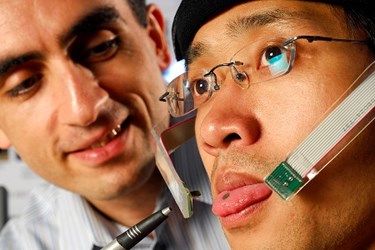More Than A Fashion Statement: Tongue Piercing Improves Wheelchair Control
By Sara Jerome,
@sarmje

Scientists are developing a wheelchair that can be controlled with the tongue, potentially giving more freedom of movement to people with spinal cord injuries.
Currently, the sip-and-puff method is the most popular approach to wheelchair control for patients who have lost the use of their arms and legs. As the name suggests, users draw air and blow through a straw to control the wheel chair. But scientists may be close improving wheelchair control technology beyond that, according to new research published in Science Translational Medicine.
"In the study, individuals with paralysis were able to use a tongue-controlled technology to access computers and execute commands for their wheelchairs at speeds that were significantly faster than those recorded in sip-and-puff wheelchairs, but with equal accuracy," the Georgia Institute Of Technology said in an announcement.
This marks the first study showing that the Tongue Drive System may outperform sip-and-puff, according to the university.
“It’s really easy to understand what the Tongue Drive System can do and what it is good for,” said Maysam Ghovanloo, a study co-author. “Now, we have solid proof that people with disabilities can potentially benefit from it.”
In the new system, the user's tongue basically becomes a joystick. "A magnetic tongue stud lets them use their tongue ... to drive the wheelchair. Sensors in the tongue stud relay the tongue’s position to a headset, which then executes up to six commands based on the tongue position," the Georgia Tech announcement said.
“Tongue piercing put to medical use — who would have thought it? It is needed and it works," said Anne Laumann, a lead investigator in the study.
The subjects in the study had to get tongue piercings to make it work, "which meant that the researchers pierced a lot of tongues," the Christian Science Monitor reported.
“Younger patients were quite receptive to receiving a tongue piercing,” Ghovanloo said in the Monitor. “In general, nobody was afraid of the little pinch and overnight tongue swelling following a tongue piercing.”
Even as new technology emerges, sip-and-puff wheelchairs continue to improve to accommodate user's varied needs. The New York Daily News recently reported on a chair that was rejiggered to allow a man to go hunting. Sipping and puffing on the mouthpiece allowed him to fire the gun.
Image credit: Gary Meek, Georgia Tech
